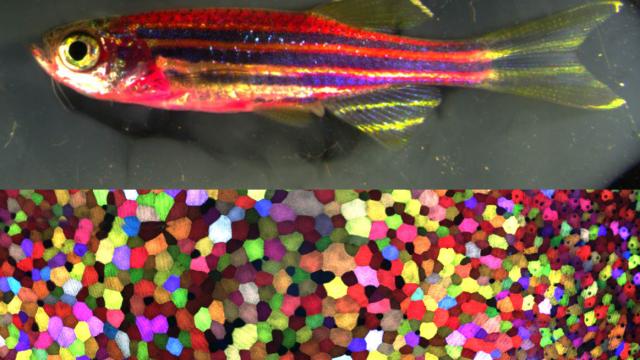It sounds ripped out of the pages of a science fiction novel — or maybe a Lisa Frank catalogue — but the genetically modified, brilliantly coloured zebra fish pictured above is no fantasy. It was created by scientists, to explore one of the most elusive processes in biology: tissue regeneration.
“We’re interested in many types of regeneration,” Ken Poss, a professor of cell biology at Duke University, told Gizmodo. “A barrier has been that we haven’t been able to visualise what the cells are doing.”
That’s why Poss and his lab have spent the last several years creating Skinbow: a mutant zebrafish with fluorescent markers embedded in the DNA code of its skin cells. Each of Skinbow’s colour markers can be expressed in three different ways, resulting in red, green or blue fluorescence. With three colour options and roughly a hundred copies of the gene per cell, the total number of colours any cell can take on, Poss said, is probably in the thousands. (With modern imaging equipment, his team can distinguish approximately 70.) The system, whose design was led by postdoctoral researcher Chen-Hui Chen, is published today in Developmental Cell.
“Each cell has an overall colour based on the combination of colour choices expressed,” Poss said. “The colour of that cell is then permanent. That’s the basis for how this line allows us to study regeneration.”
Now Poss and his lab can perform experiments — for instance, scraping a few cells off the fin of a technicolor zebrafish — and visualise the healing process on a cellular level. Any colour patterns that develop during tissue regeneration are inferred to arise from a single cell.
“One thing we weren’t expecting is that within a few hours of injury, cells that are spared acquire some mobility on the surface,” Poss said. “They also expand in size, some doubling. Then there’s a quick wave of replacement — you can see new cells emerging from the layer underneath.”
Zebrafish are a classic model organism, and they’re particularly well suited to tissue regeneration studies. The animals can patch an injured heart or spinal cord, and even regrow entire limbs. But Poss is hopeful that Skinbow can be extended to other species in the future — even humans. One can imagine doctors using the technology to visualise how human tissue responds to, say, a new cancer drug, or a treatment meant to accelerate healing.
“In theory, this general platform is applicable to other tissues and other species,” Poss said. “It involves getting the right set of genetic tools, and developing a way to image that tissue continually over time.”
Top: Skinbow is a new colour-coding technique that can be used to visualise tissue regeneration. Image Credit: Chen-Hui Chen / Duke
